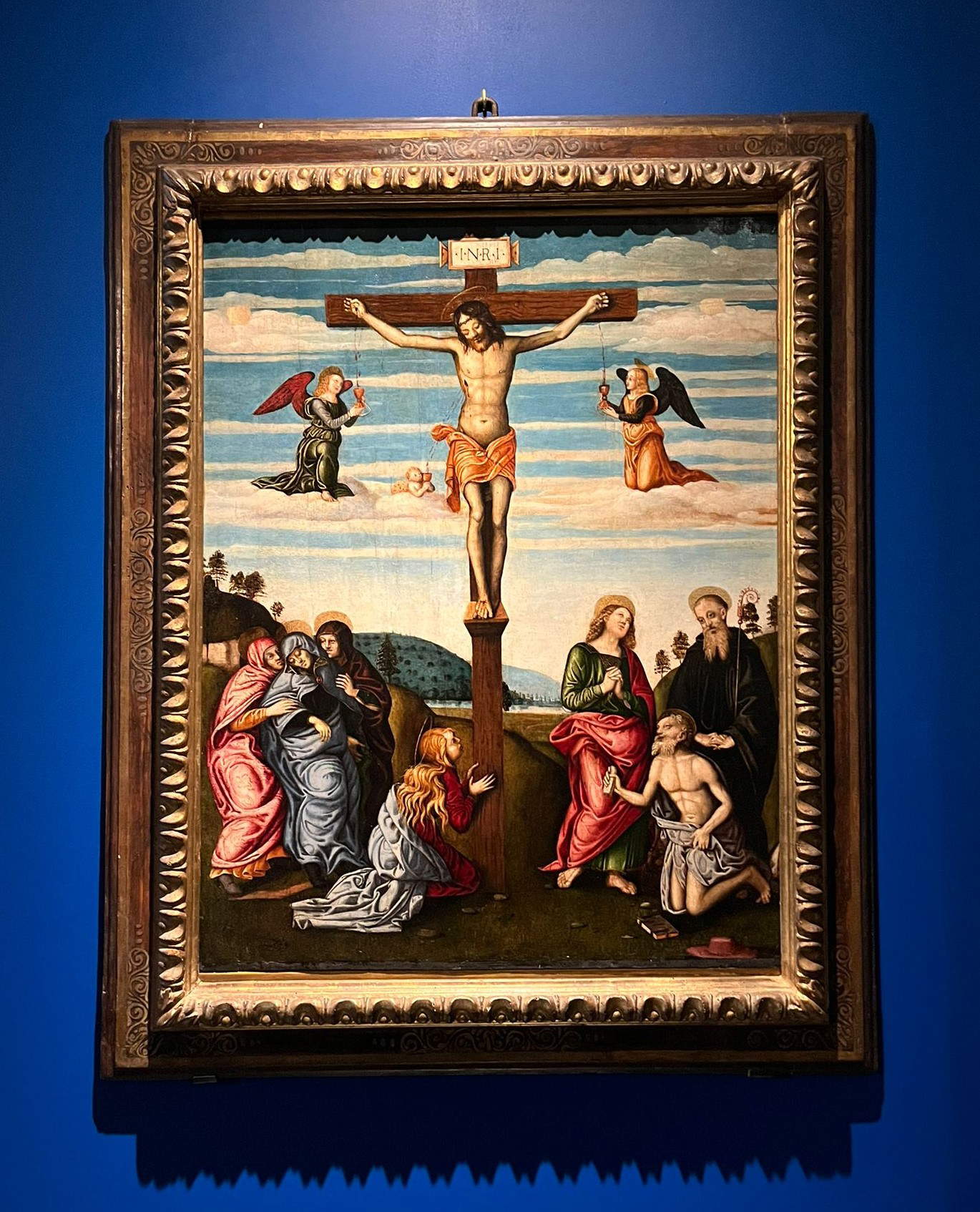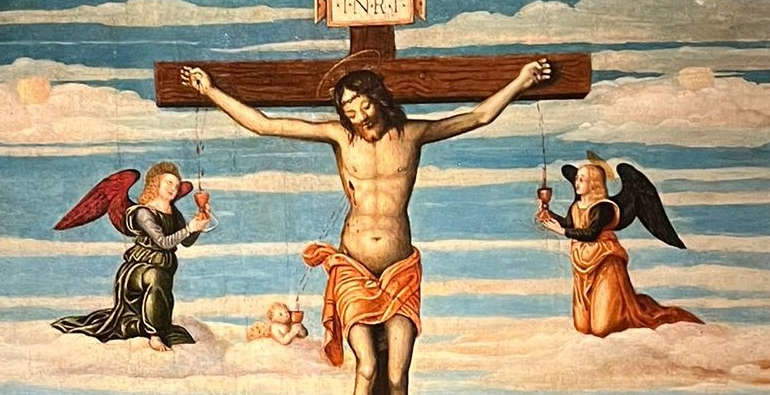The Crucifixion by the so-called Master of San Vincenzo Martire is finally on public display in the new Renaissance section of the Ducal Palace in Mantua, which opened Oct. 25 at the Castle of San Giorgio, part of the institute’s itinerary. The painting, recently acquired by the Ducal Palace, is a small work (94x73 cm) and depicts Christ crucified, with Mary Magdalene kneeling at his feet, the Virgin fainting on the left and Saints John the Evangelist, Benedict and Jerome arranged to the right of the Redeemer.
The painting has been identified in the antiques market and recognized by Stefano L’Occaso and, independently by, Mauro Minardi, as the work of the “Master of St. Vincent Martyr.” The title “Master of. ”, assigned by convention to an artist whose name is unknown, refers to a large Mantuan altarpiece depicting the Madonna and Child between Saints Vincent Ferrer, John the Baptist, Hosanna Andreasi, Vincenzo Levita, Barbara and Romano, located in the Ducal Palace and coming from the church of the Dominican nuns of San Vincenzo in Mantua: hence the name by which the still anonymous master was “baptized” by scholars.

In the world of art history, it happens that some artistic figures are recognizable through a coherent body of work, while remaining unknown in name and biographical details. Such is the case with the “Master of San Vincenzo Martire,” an appellation referring to the first work traceable to this anonymous hand, a particularly significant work in the painting tradition of early 16th-century Mantua.
Stylistic characteristics and details of iconography have allowed art historians to link a large catalog of works to the Master of St. Vincent Martyr. Before critics recognized the stylistic unity of this group, the paintings had been erroneously attributed to several artists, including Luigi Anguissola, Girolamo Marchesi da Cotignola, Francesco Zaganelli, and Bernardino Bonsignori. However, none of these attributions were ever conclusively confirmed until the suspicion emerged that these works shared specific traits with the style of Pietro Perugino.
The Master of St. Vincent Martyr seems to have been strongly influenced by two masters of the Italian Renaissance: Andrea Mantegna and Pietro Perugino, the latter of whom was described by his contemporaries as “the best master of Italy.” The celebrated Perugino was particularly appreciated in the city of Mantua: Isabella d’Este, a patron of the arts and one of the most important cultural figures of the time, attempted on several occasions to obtain his works for her collection. Two artists from Mantua had direct contact with Perugino in Florence, where the latter maintained a workshop in the early 16th century. These included, in addition to the celebrated Lorenzo Leonbruno, Bartolomeo Fancelli, an artist about whom little information is available but who appears to have been increasingly linked to the work of the Master of San Vincenzo Martire.
According to documents, Bartolomeo Fancelli worked at Perugino’s workshop in Florence in the first decade of the 16th century, then moved to Mantua, around 1520. Only one work is known of him, signed and dated 1507 and kept in a private collection. His father, Bernardo, belonged to a family of Settignano origin that moved to Mantua as early as the mid-15th century. Among the most distinguished members of the family was Luca Fancelli, an architect in the service of the Gonzagas, while Chiara, Luca’s daughter, was the wife of Perugino himself, thus underscoring the Fancelli family’s deep ties to Mantua and Renaissance culture.
The work now on display on the ground floor of the Castello di San Giorgio reveals a peculiar influence of Perugino, observable in the delicacy of the faces and the harmonious rendering of the figures, immersed in an atmosphere of calm suffering, but also of the perspective and symbolic sobriety typical of Mantegna. The Master of San Vincenzo Martire, unlike other Mantuan artists, worked primarily on panel, a rare medium for early 16th-century production in the city of the Gonzagas, which was predominantly oriented toward painting on canvas or fresco. This unusual use of the panel highlights the artist’s Florentine and Umbrian training, suggesting that his activity took place mainly in the Mantuan area.
The Crucifixion, with its composition and stylistic traits, also testifies to a possible attribution to Bartolomeo Fancelli: the presence of direct derivations from Perugino’s style and the painter’s return to Mantua suggest that this is one of the few remaining examples of his work.
"Who else but Bartolomeo Fancelli, a Mantuan born at the court of Mantegna and trained with Perugino, could have proposed the curious cocktail that the Crucifixion offers us?“ This is the question posed by Stefano L’Occaso, director of the Ducal Palace. ”Our panel mixes, in fact, Perugino’s Chigi Crucifixion, in Siena (church of Sant’Agostino), with the Mantegnaesque Noli me tangere from the National Gallery in London, from which he copies the Magdalene. The work was purchased by Perugino antiquarian Fabio Mearini, who had the panel restored and whom I thank."
The acquisition and display of the “Crucifixion” mark an important step for the Ducal Palace and the Castle of San Giorgio, not only as a testimony to the Mantuan Renaissance, but also as evidence of the spread of Florentine and Umbrian artistic influences in northern Italy. The new exhibition dedicated to the Renaissance collection represents a unique opportunity to deepen our knowledge of the artistic currents that passed through Mantua in the early 16th century, a period of great artistic development under the protection of the Gonzaga family.
The exhibition also makes it possible to enhance the figure of the Master of San Vincenzo Martire, an author who, although not a great innovator, represents a valuable record of Mantuan painting and its ability to absorb outside influences. The work, so rich in detail and symbolism, will appeal not only to art history scholars, but also to visitors who will be able to explore one of the lesser-known aspects of Italian Renaissance painting production.
Scholars and curators at the Ducal Palace will continue to investigate the Master of St. Vincent Martyr, hoping to identify additional works and details that may confirm the hypothesis of attribution to Bartolomeo Fancelli. The new Renaissance display at the Castello di San Giorgio could thus become the starting point for new research on early 16th-century painting in Mantua, helping to unravel further pieces of the complex artistic network that linked Mantua to Florence and Perugia.
Pending new discoveries, the Crucifixion stands out as a rare testimony to the artistic continuity of the period and Perugino’s particular influence on the Mantuan school, and represents tangible evidence of the Gonzaga city’s artistic past.
 |
| Mantua, new acquisition for Ducal Palace: the Crucifixion by the Master of St. Vincent Martyr |
Warning: the translation into English of the original Italian article was created using automatic tools. We undertake to review all articles, but we do not guarantee the total absence of inaccuracies in the translation due to the program. You can find the original by clicking on the ITA button. If you find any mistake,please contact us.